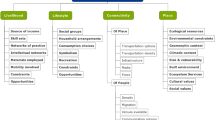Abstract
ZimFlores (version 4) is the outcome of a participatory modelling process and seeks to provide a shared factual basis for exploring land-use options for the communal lands surrounding the Mafungautsi forest. The ZimFlores experience underscores the importance of a sharing a common problem and a common location in which all participants have an interest. Participatory modelling has proved an effective way to consolidate a diverse body of knowledge and make it accessible. Results demonstrate the importance of model outputs that are diagnostic, and which offer insights into the issues under consideration.
Similar content being viewed by others
References
Campbell, B.M. ed. (1996),The Miombo in Transition: Woodlands and Welfare in Africa, Center for International Forestry Research, Bogor.
Campbell, B.M. and Matose, F. (2000),Institutions and Natural Resources in the Miombo Region, CIFOR/EC/SADC Miombo Woodlands Research Brief No. 5, May 2000.
Forrester, J.W. (1961),Industrial Dynamics, Pegasus Communications, Waltham MA.
Frost, P.G.H. and Mandono, A. (1999),Improving Rural Livelihoods in Semi-Arid Regions Through Management of Micro-Catchments, Working paper No. 12, Institute of Environmental Studies, University of Zimbabwe.
Gambiza, J., Bond, W., Frost, P.G.H., Higgins, S. (2000), ‘A simulation model of miombo woodland dynamics under different management regimes’,Ecological Economics, 33: 353–368.
Haggith, M. and Prabhu, R. (2003), ‘Unlocking complexity: The importance of idealisation in simulation modelling,’Small-scale Forest Economics, Management and Policy, 2(2): 293–312.
Haggith, M., Muetzelfeldt, R.I. and Taylor, J. (2003a), ‘Modelling decision-making in rural communities at the Forest Margin’,Small-scale Forest Economics, Management and Policy, 2(2): 241–258.
Haggith, M., Prabhu, R., Mudavanhu, H., Matose, F., Mutimukuru, T., Nyirenda, R. and Standa-Gunda, W. (2003b), ‘The challenges of effective model scoping: A FLORES case study from the Mafungautsi Forest margins, Zimbabwe’,Small-scale Forest Economics, Management and Policy, 2(2): 155–169.
Haggith, M., Prabhu, R., Colfer, C., Ritchie, B., Thomson, A. and Mudavanhu, H. (2003c), ‘Infectious ideas: Modelling the diffusion of ideas across social networks,’,Small-scale Forest Economics, Management and Policy, 2(2):225–239.
Kim, D.H. (1995),Systems Thinking Tools, Pegasus Communications, Cambridge, MA.
Monela, G.C., Kajembe, G.C., Kaoneka, A.R.S. and Kowero, G. (2000), ‘Household livelihood strategies in the Miombo Woodland of Tanzania: Emerging trends’,Tanzania Journal of Forestry and Nature Conservation, 73: 17–33.
Morecroft, J.D.W. and Sterman, J.D. eds. (1994),Modeling for Learning Organisations, Productivity Press, Portland, OR.
Muetzelfeldt, R. and Massheder, J. (2003), ‘The Simile visual modelling environment’,European Journal of Agronomy, 18(3–4): 345–358.
Mukamuri, B.B., Campbell, B.M., and Kowero, G. (2003), ‘Local organisations and natural resource management in the face of economic hardships: A case study from Zimbabwe’,Tanzania Journal of Forestry and Nature Conservation, 75, in press.
Standa-Gunda, W., Mutimukuru, T., Nyirenda, R., Haggith, M. and Vanclay, J.K. (2003), ‘Participatory modelling to enhance social learning, collective action and mobilization among users of the Mafungautsi Forest, Zimbabwe’,Small-scale Forest Economics, Management and Policy, 2(2): 313–326.
Sterman, J.D. (2000),Business Dynamics: Systems Thinking and Modeling for a Complex World, McGraw-Hill, New York.
Vanclay, J.K. (2003), ‘Why model landscapes at the level of households and fields?’,Small-scale Forest Economics, Management and Policy, 2(2): 121–134.
Vanclay, J.K., Haggith, M. and Colfer, C. (2003), ‘Participation and model-building: Lessons learned from the Bukittinggi workshop’,Small-scale Forest Economics, Management and Policy, 2(2): 135–154.
Author information
Authors and Affiliations
Additional information
Many people contributed in many ways to help realize ZimFlores. Some of the people who contributed include Elias Ayuk, Ivan Bond, Ephraim Chabayanzara, Muyeye Chambwera, Vijay Datadin, Wil de Jong, Peter Frost, James Gambiza, Jode Garbe, Peter Gondo, Emmanuel Guveya, Chiedza Gwata, John Hansell, Gideon Kamumvuri, Godwin Kowero, Dominic Kwesha, Chris Legg, Tim Lynam, Hilton Madevu, Simba Mandota, Everisto Mapedza, Frank Matose, Gutura Matoso, Chipo Mlambo, John Mudekwe, Maxwell Mukwekwerere, Dorcas Mungwari, Tendayi Mutimukuru, Mkhululi Ngwenya, Richard Nyirenda, Bill Ritchie, Lizwelabo Sibanda, Manasa Sibanda, Fergus Sinclair, Jivas Sithutha, Jasper Taylor, Michael Thomas, Zivanai Tsvuura and Steve Twomlow. We are grateful to the UK’s Department for International Development (DFID) and the European Community for financial support of this project.
Rights and permissions
About this article
Cite this article
Prabhu, R., Haggith, M., Mudavanhu, H. et al. ZimFlores: A model to advise co-management of the mafungautsi forest in Zimbabwe. Small-scale Forestry 2, 185–210 (2003). https://doi.org/10.1007/s11842-003-0015-5
Issue Date:
DOI: https://doi.org/10.1007/s11842-003-0015-5




